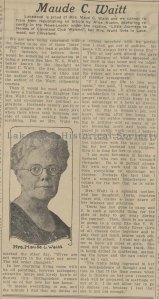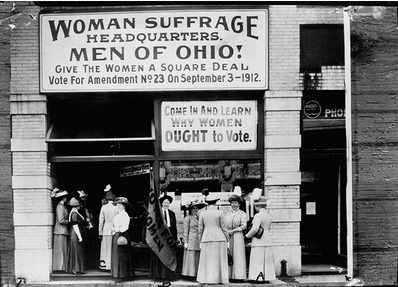
As the month of March comes to an end, I find that (a) it has flown by and (b) there is so much history to be told and discussed. This certainly takes quite a bit of time to thoroughly research and ensure accuracy/legitimacy of the sources that are used. Especially with political issues bombarding us in the media and in our everyday lives, it is appropriate to stress the need to become educated on political issues in our society; trying to the best of our ability to get the whole story. The final post in the Women’s History Month series, highlights some of the changes that occurred after the passage of the 19th Amendment to the U.S. Constitution which resulted in the formation of an organization whose purpose is just that…educate the community on political issues. Now, it is important for everyone to know what the 19th Amendment states, since it was a pivotal legislative decision that still affects us today.
- The right of the citizens of the United States to vote shall not be denied or abridged by the United States of by any State on account of sex.
- Congress shall have the power to enforce this article by appropriate legislation.
The Lakewood Women’s Suffrage Party, formed in 1912, worked diligently for five years to pass a local measure to include women in local government decision-making. These efforts eventually resulted in the 1917 vote that allowed the Lakewood Ladies to officially participate in the democratic process. It was not until 1920 that states voted to ratify a national Women’s Suffrage amendment.

The members of the Lakewood Women’s Suffrage Party transformed their organizational mission in 1922 to focus on the education of the new population of voters-women. So, the Lakewood League of Women Voters (LWV) grew out of the Lakewood Women’s Suffrage Party. (It is important to note at this point, that this was a common transformation that occurred within many of the Women’s Suffrage Parties across the country.)

There is some debate, looking at the newspaper clippings we have in our collections about whether or not the Lakewood chapter of the LWV is the oldest in the state, or the second. However, the fact remains that it was one of the first to establish itself after the 1920 ratification of the 19th Amendment! In 1924, two years after the establishment of the Lakewood LWV, its membership numbered 481. In 1967, in celebration of the first 45 years of the LWV, one of the original members, Mrs. Jesse W. Woods, reflected that, “[W]hen we organized the league back in ’22 women were very ignorant of politics and very uninterested…They didn’t even know parliamentary procedure…”

 Bernice was a prominent suffragette in Lakewood and assumed the presidency of the Lakewood Women’s Suffrage Party in 1914 where she raised $400 from the district which earned her the distinction raising the most funds in the Greater Cleveland area.
Bernice was a prominent suffragette in Lakewood and assumed the presidency of the Lakewood Women’s Suffrage Party in 1914 where she raised $400 from the district which earned her the distinction raising the most funds in the Greater Cleveland area.  Pyke also was the first woman to campaign for Mayor of Lakewood, hold a cabinet position in Cleveland City government, and, as stated previously, served as a delegate to the Democratic National Convention in 1920. While she was unsuccessful in her mayoral campaign, Bernice continued her involvement in politics with a state senatorial campaign and addressed the 1932 Democratic Part at the convention where she was skeptical of presidential candidate, Franklin Delano Roosevelt. After Roosevelt’s victory in the
Pyke also was the first woman to campaign for Mayor of Lakewood, hold a cabinet position in Cleveland City government, and, as stated previously, served as a delegate to the Democratic National Convention in 1920. While she was unsuccessful in her mayoral campaign, Bernice continued her involvement in politics with a state senatorial campaign and addressed the 1932 Democratic Part at the convention where she was skeptical of presidential candidate, Franklin Delano Roosevelt. After Roosevelt’s victory in the  presidential race, he actually appointed Pyke as the director of customs collection for Ohio, which she held for 20 years and two presidents waived the mandatory retirement age for her. Those presidents were Harry Truman and Dwight Eisenhower.
presidential race, he actually appointed Pyke as the director of customs collection for Ohio, which she held for 20 years and two presidents waived the mandatory retirement age for her. Those presidents were Harry Truman and Dwight Eisenhower. influences the women and girls of Lakewood had on our community, state, and country. For instance, as I’m looking for just the right piece from The Cinema to go in our exhibit, I came across the Girls’ Athletic Association entries. In a time when we are so used to women being involved with sports like basketball, tennis, volleyball, field hockey, and swimming, it can be easy to overlook the athletes of decades past. The 1970s brought with it the passage of Title IX, allowing for the inclusion of girls in sports across the country. But, how many realize that girls and young women participated in sports prior to that at L.H.S? According to the 1929 edition of The Cinema, the Lakewood High School female athletes
influences the women and girls of Lakewood had on our community, state, and country. For instance, as I’m looking for just the right piece from The Cinema to go in our exhibit, I came across the Girls’ Athletic Association entries. In a time when we are so used to women being involved with sports like basketball, tennis, volleyball, field hockey, and swimming, it can be easy to overlook the athletes of decades past. The 1970s brought with it the passage of Title IX, allowing for the inclusion of girls in sports across the country. But, how many realize that girls and young women participated in sports prior to that at L.H.S? According to the 1929 edition of The Cinema, the Lakewood High School female athletes  did not compete inter-scholastically with other schools, like their male counterparts. But, they were fiercely competitive. Just some of the sports these young ladies participated in included hockey (this was not the hockey we associate with ice and a puck, it was instead field hockey), basketball, volley ball [sic], tennis, and even life saving.
did not compete inter-scholastically with other schools, like their male counterparts. But, they were fiercely competitive. Just some of the sports these young ladies participated in included hockey (this was not the hockey we associate with ice and a puck, it was instead field hockey), basketball, volley ball [sic], tennis, and even life saving.
 Much like what we did at Lakewood Historical Society over the course of February, highlighting the unique and important role African Americans played in the history of Lakewood, we will showcase many of the achievements and impacts of Lakewood’s Women. Stay tuned for our first installment of the Ladies of Lakewood series…Votes for Women!
Much like what we did at Lakewood Historical Society over the course of February, highlighting the unique and important role African Americans played in the history of Lakewood, we will showcase many of the achievements and impacts of Lakewood’s Women. Stay tuned for our first installment of the Ladies of Lakewood series…Votes for Women!